In June 2023, Dataiku and Databricks surveyed 400 senior artificial intelligence (AI) professionals in large companies around the world. We of course looked at the attitudes and adoption of Generative AI. Survey questions also asked about the modern data stack, spend on AI tools and services, AI use case reach, and more. Here are five of the most surprising stats from this AI survey — get more insights in the full survey.
45% of Respondents Are Already Experimenting With Generative AI
On the surface, this might seem like a surprisingly high figure. How is it that 45% of senior AI professionals say they’re working actively on Generative AI use cases already?
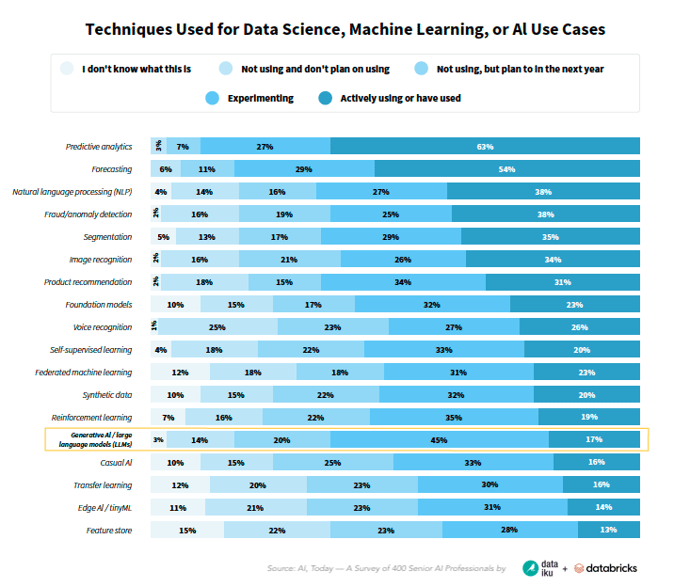
With the widespread use of the technology not even a year old, this is nothing short of amazing. And on top of that, more than 60% of respondents say they will use Generative AI over the next year. This includes large language models (LLMs), which is emerging as a top driver of use cases.
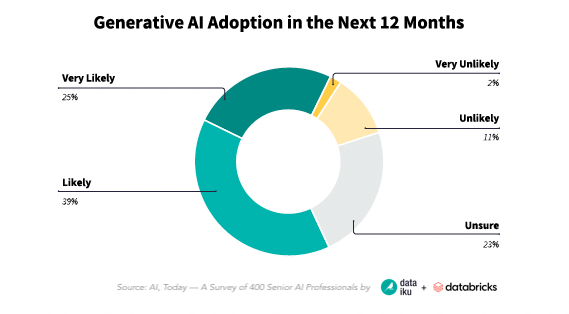
With Generative AI, we have reached a turning point in AI. However, the willingness to embrace the technology and readiness of companies to leverage it is not something that happened overnight.
Over the past five to ten years, people at organizations across all industries have been laying the groundwork. They’ve been working with self-service analytics, encouraging enterprise-wide adoption of more advanced use of data. They’ve been putting governance and MLOps systems in place to allow for the safe scaling of AI. They’ve been slowly but surely increasing their AI maturity and capabilities — just in time for the Generative AI wave.
75% of Senior AI Professional Report Positive ROI From AI
Our AI survey found that the overwhelming majority of respondents are now reporting positive return on investment (ROI) from AI. This is a major indicator of this overall increase in maturity. As AI continues to mature and evolve, businesses are reaping the rewards of their investments in this transformative technology.
There is slight variation by industry and by region, but overall this is a sign that the groundwork is paying off. We’re beyond the world of one-off proofs of concept (PoCs). We're beyond data teams working in a silo (more on this later), and have moved into large scale AI deployment.
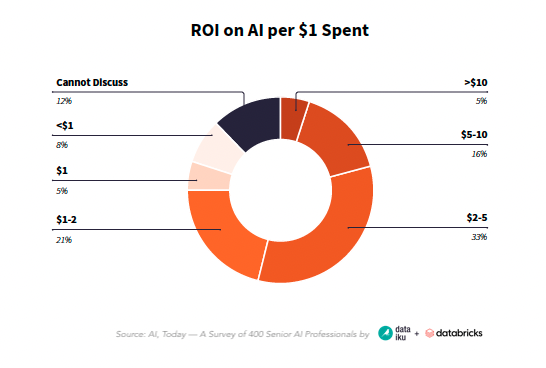
More globally, this statistic is a sign that AI professionals are getting a handle on all of the basics, including:
- Setting specific and measurable short-term goals for AI and data projects. Case in point: Our AI survey also found 37% of respondents were advanced in their ability to calculate and track ROI.
- At the same time, also maintaining a long-term vision for how AI and data can continuously drive value and innovation.
Breaking down silos to create a unified data ecosystem for faster and more informed decision making. - Embracing AI for the automation of repetitive tasks and processes. This can often have huge benefits to free up human resources for more strategic work.
⅓ of Organizations Leverage a “Hub & Spoke” Operational Structure for AI
A mere two to three years ago, everyone was talking about the centralized center of excellence (CoE) for AI initiatives. Which makes sense, as this model jumpstarts AI model adoption within organizations.
A few years on, more leaders are evolving their organization to mirror their level of AI maturity. Today, a full third of AI professionals say they are leveraging the hub and spoke model. In manufacturing, this number shoots up to 42% in our survey findings. The hub and spoke model is a natural evolution of the CoE.
That said, the CoE is still the most popular model, with 39% of respondents using it. However, the fact that hub and spoke is gaining traction is a sign of overall rising maturity in organizations worldwide.
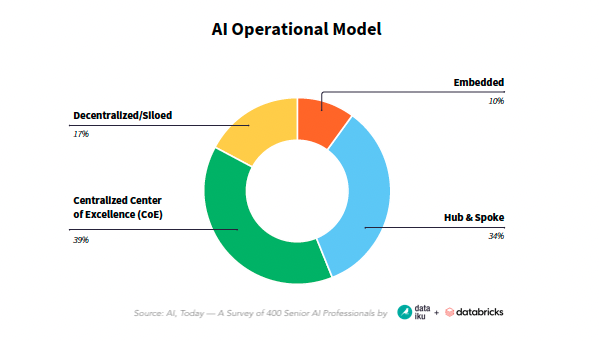
Individual teams within a company do their own independent experimentation with AI.
Little to no sharing of infrastructure, data, best practices, or talent.
Almost always a temporary operating model, where the goal is to determine if there’s enough AI value to further invest.
This operating model, known as a CoE, is designed to jumpstart the adoption of AI within an organization.
A centralized team develops and maintains AI products for many business units and functions.
CoE functions get distributed around an organization. AI experts (advanced, graduate-level data scientists) are in the hub, and business units and functions are in the spokes. They collaborate on product development.
Like in a CoE, the hub is responsible for infrastructure, standards, and tracking industry innovation.
However, ownership of AI products shifts to the spokes.
Very few central, shared resources and rules such as Responsible AI guidelines, infrastructure, and a few common, curated datasets.
The most decentralized, agile, and innovative structure. Many business units are involved, and they are loosely connected by rules and resources.
Over Half Are More Worried Than Excited About the Future of AI
Our survey shows that people across multiple industries are anxious about the future of AI. With the rise of Generative AI, we are in uncertain waters, to be sure.
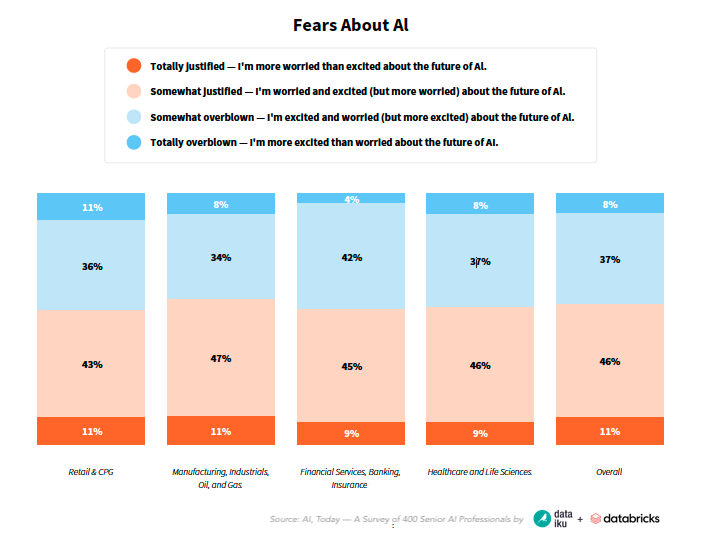
Why might senior AI and machine learning professionals be worried about the future of AI?
Our survey results reveal that AI professionals are still facing some very real challenges in democratizing data. For example, data quality still appears to be a speed bump, especially in the context of huge amounts of data. This is true both for more mature AI organizations and less mature organizations alike.
The good news and the bottom line is that there are many signs of success and progress as well. For example, 55% of respondents say they have clear owners of data quality. And 45% say that high quality data is available to front-line people when they need it.
¾ Say They Develop Advanced Analytics & AI With an Interdisciplinary Team
In the rapidly evolving landscape of AI, the collaborative power of interdisciplinary teams is a driving force behind successful projects.
At Dataiku, we’ve been talking about true collaboration between data and non-data experts for more than 10 years. Democratization of data (and now Generative AI) won’t happen if the tools and technologies stay in the hands of the few.
The interdisciplinary approach also addresses responsible implications of AI development. By incorporating diverse viewpoints, organizations can identify potential biases, consider the broader impact of their AI solutions, and uphold responsibility standards.
The good news is that interdisciplinary teams (i.e., business people working with data people) today are becoming status quo. The overwhelming majority of respondents (77%) said they are working cross-functionally — just in time for the next wave of AI.






